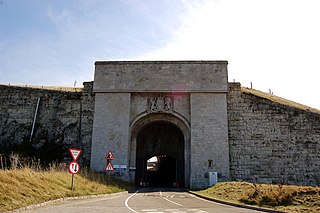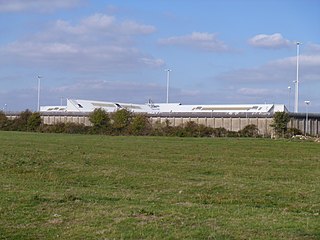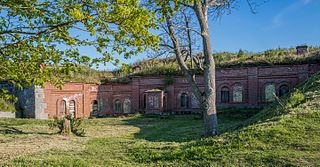
Suomenlinna, or Sveaborg, is an inhabited sea fortress composed of eight islands, of which six have been fortified; it is about 4 km southeast of the city center of Helsinki, the capital of Finland. Suomenlinna is popular with tourists and locals, who enjoy it as a picturesque picnic site. Originally named Sveaborg, or Viapori as referred to by Finnish-speaking Finns, it was renamed in Finnish to Suomenlinna in 1918 for patriotic and nationalistic reasons, though it is still known by its original name in Sweden and by Swedish-speaking Finns. Due to its strategic geographical location, it sometimes used to be known as Gibraltar of the North.

Parole is a form of early release of a prison inmate where the prisoner agrees to abide by behavioral conditions, including checking-in with their designated parole officers, or else they may be rearrested and returned to prison.

San Quentin Rehabilitation Center (SQ), formerly known as San Quentin State Prison, is a California Department of Corrections and Rehabilitation state prison for men, located north of San Francisco in the unincorporated place of San Quentin in Marin County.

Rikers Island is a 413-acre (167.14-hectare) prison island in the East River in the Bronx that contains New York City's largest jail.

HM Prison The Verne is a Category C men's prison located within the historic Verne Citadel on the Isle of Portland in Dorset, England. Operated by His Majesty's Prison Service, HMP The Verne was established in 1949 and occupies the southern part of the citadel. After a brief spell as an Immigration Removal Centre in 2014–2017, HMP The Verne re-opened in 2018.

The Suomenlinna Church in Helsinki, Finland, was built in 1854 as an Eastern Orthodox garrison church for the Russian troops stationed at the Suomenlinna sea fortress. The fortress comprises five islands joined together by bridges, and the church is the central feature on the island of Iso Mustasaari, located at its highest point. It is surrounded by other fortress buildings, but the old parade ground is immediately to the east, and a park lies immediately to the south. It is oriented southwest to northeast so that it would align with the Crownwork Ehrensvärd defense front located to the southwest of the church.

The Market Square is a central square in Helsinki, Finland. It is located in central Helsinki, at the eastern end of Esplanadi and bordering the Baltic Sea to the south and Katajanokka to the east. HSL maintains a year-round ferry link from Market Square to Suomenlinna, and in the summer there are also private companies providing ferry cruises, both to Suomenlinna and to other nearby islands. The Presidential Palace, Helsinki City Hall, Swedish Embassy and the Stora Enso Headquarters building are all located adjacent to Market Square.

Kuivasaari is a Finnish island in the Gulf of Finland, near Helsinki.

HM Prison Long Lartin is a Category A men's prison, located in the village of South Littleton in the Wychavon district in Worcestershire, England. It is operated by His Majesty's Prison Service.
HM Prison Gartree is a Category B men's prison, located in Market Harborough, Leicestershire, England. Gartree is operated by His Majesty's Prison Service.

The Military Museum of Finland is the central museum of the Finnish Defence Forces and the national special museum of military history. It is located in Helsinki and it is part of the Finnish National Defence University. In 2018, the Military Museum's exhibitions in Suomenlinna had around 131,000 visitors. The most popular exhibition is the submarine Vesikko, visited by around 50,000 people annually. Military Museum's exhibitions in Suomenlinna are located at Manege and Artillery Maneage.
HM Prison Ashwell was a Category C men's prison located in the parish of Burley, in the county of Rutland, England. The site of the former prison is located about two miles south of the centre of the village of Ashwell, alongside the road to Oakham and opposite the former kennels of the Cottesmore Hunt.

The Krepost Sveaborg was an Imperial Russian system of land and coastal fortifications constructed around Helsinki during the First World War. The purpose of the fortress was to provide a secure naval base for the Russian Baltic fleet and to protect Helsinki and block routes to Saint Petersburg from a possible German invasion. Krepost Sveaborg was part of Peter the Great's Naval Fortress, a coastal fortification system protecting access to Saint Petersburg by sea. The central part of Krepost Sveaborg was the old fortress of Suomenlinna where the fortress headquarters were located. Due to technological advances in artillery the old fortress was no longer capable of providing a sufficient protection, and a new main defensive line was built well beyond the old fortress boundaries. New coastal artillery guns built on outlying islands protected Krepost Sveaborg from the sea, while fortified lines constructed around Helsinki were intended to stop any attacks on land. The primary coastal guns were 10 in (254 mm) model 1891 guns and 6 in (152 mm) model 1892 Canet guns. Older 11 in (279 mm) model 1877 guns were also used. In summer 1917 the fortress had two hundred coastal or anti-landing guns, of which 24 were 10-inch guns in six batteries, 16 were 6-inch Canet guns in four batteries and twelve were 11-inch guns in three batteries. The artillery used in land fortifications included older coastal guns, old fixed carriage guns and newer light field guns. In March 1917, Krepost Sveaborg had a total of 463 guns, although many of them were obsolescent. Krepost Sveaborg was still partly incomplete in 1917 when the February Revolution halted most of the construction work. Some further construction work was carried out during the remaining year, but all work halted during the October Revolution. Following the Finnish Declaration of Independence, parts of the land fortifications were used in the Finnish Civil War. The coastal fortifications were later taken over by Finland to protect Helsinki, while the land fortifications were mostly abandoned and disarmed.

Finnish Civil War prison camps were operated by the White Finns to hold prisoners of war during and after the Finnish Civil War in 1918.

Vallisaari is an island in Helsinki, Finland. It is located between Suomenlinna and Santahamina.

Suomenlinna prison camp was a 1918 Civil War of Finland concentration camp in the Suomenlinna Fortress, Helsinki. It was established by the White Army for the Red Guard fighters taken prisoner after the Battle of Helsinki. The camp operated from April 1918 to March 1919. It was a subcamp for the Helsinki prison camp, which included the camps of Suomenlinna, Santahamina, Katajanokka and Isosaari.

Lonna is a small island off Helsinki, opposite the Suomenlinna Passenger terminal. The island belongs to the Suomenlinna district. Lonna is about 150 meters long and the distance to the mainland is about 1.5 kilometers.

Suomenlinna is a village-like district of the city of Helsinki, Finland with about 700 inhabitants. Its best known part is the maritime fortress of Suomenlinna.

The Governing Body of Suomenlinna is a bureau belonging to the Ministry of Education and Culture in Finland, whose task is to restore, maintain, demonstrate and govern the island fortress of Suomenlinna, a Unesco World Heritage, in Helsinki, Finland. The governing body was founded in 1973 when ownership of Suomenlinna was transferred from the Finnish Defence Forces to a civilian government. The organisation is divided into four units, consisting of government, maintenance, world heritage and restoration services.
















